As an avid bikejoring enthusiast, I’ve had the privilege of learning from the best in the sport. From seasoned trainers to experienced competitors, I’ve gathered valuable insights on how to prepare a dog for a bikejoring race. Bikejoring, also known as dog biking or cycling with dogs, is a thrilling activity that requires careful planning, patience, and dedication. Whether you’re a seasoned pro or a newcomer to the world of bikejoring, understanding how to properly prepare your canine companion is crucial for a successful and enjoyable experience.
Introduction to Bikejoring
Bikejoring is a sport that involves riding a bicycle while harnessed to a dog, typically a high-energy breed such as a Siberian Husky or an Alaskan Malamute. The dog runs alongside the bike, pulling the rider and providing a thrilling workout for both the dog and the cyclist. However, before you can hit the trails with your furry friend, it’s essential to prepare them for the demands of bikejoring. This involves building their endurance, strengthening their muscles, and teaching them to respond to commands while in harness.
Understanding Canine Anatomy and Physiology
Before diving into the world of bikejoring, it’s crucial to understand the anatomy and physiology of your dog. This includes their musculoskeletal system, cardiovascular system, and respiratory system. According to Dr. Jennifer Solomon, a veterinarian specializing in canine sports medicine, “dogs are designed for short bursts of energy, not long-distance running.” Therefore, it’s essential to gradually build your dog’s endurance to avoid injuries and prevent exhaustion. This can be achieved through a combination of short runs, walking, and playtime, gradually increasing the duration and intensity of their workouts.
Building Endurance and Strengthening Muscles
Building your dog’s endurance and strengthening their muscles is critical for bikejoring. This can be achieved through a variety of exercises, including:
- Short runs: Start with short runs of 10-15 minutes, gradually increasing the duration as your dog becomes more conditioned.
- Walking: Incorporate walking into your dog’s daily routine, either on a leash or in a controlled off-leash environment.
- Playtime: Engage your dog in play activities such as fetch, agility training, or hide-and-seek to improve their overall fitness and coordination.
- Hill sprints: Incorporate short hill sprints into your dog’s workout routine to build their explosive power and endurance.
- Strength training: Incorporate strength training exercises such as weight pulling or resistance band training to build your dog’s muscular strength and endurance.
It’s essential to remember that every dog is different, and their training should be tailored to their individual needs and abilities. According to Mike Williams, a seasoned bikejoring competitor, “it’s crucial to listen to your dog’s body and adjust their training accordingly. If they’re showing signs of fatigue or stress, it’s time to slow down and reassess their workout routine.”
Teaching Commands and Harness Training
Teaching your dog to respond to commands while in harness is critical for bikejoring. This includes teaching them to respond to basic commands such as “start,” “stop,” and “turn,” as well as more advanced commands such as “left” and “right.” Harness training is also essential, as it helps your dog become comfortable with the sensation of wearing a harness and pulling a load. According to Karen Thompson, a professional dog trainer, “harness training should start with short sessions, gradually increasing the duration as your dog becomes more comfortable and confident.”
Introduction to Bikejoring Equipment
Bikejoring equipment is designed to provide a safe and comfortable experience for both the dog and the rider. This includes a specially designed harness, a towing line, and a bike attachment. The harness is designed to distribute the force of the tow line across your dog’s chest and shoulders, providing a comfortable and secure fit. The towing line is designed to provide a safe and shock-absorbing connection between the dog and the bike, while the bike attachment provides a secure and stable platform for the rider. According to John Lee, a bikejoring equipment manufacturer, “the right equipment can make all the difference in the world. It’s essential to choose equipment that’s designed specifically for bikejoring and to follow the manufacturer’s instructions for use and maintenance.”
Training for Bikejoring Competitions
Training for bikejoring competitions requires a combination of physical conditioning, mental preparation, and strategic planning. This includes building your dog’s endurance and strength, teaching them to respond to commands, and developing a racing strategy that takes into account the course, the weather, and your dog’s abilities. According to Sarah Johnson, a professional bikejoring competitor, “the key to success in bikejoring competitions is to stay focused, stay calm, and trust in your dog’s abilities. With proper training and preparation, you and your dog can achieve great things and have a blast doing it.”
Conclusion
In conclusion, preparing a dog for a bikejoring race requires careful planning, patience, and dedication. By understanding canine anatomy and physiology, building endurance and strengthening muscles, teaching commands and harness training, introducing bikejoring equipment, and training for bikejoring competitions, you can help your dog become a confident and capable bikejoring partner. Remember to always prioritize your dog’s safety and well-being, and to seek the advice of experienced trainers and competitors to ensure that you and your dog have a successful and enjoyable bikejoring experience.
As you embark on your bikejoring journey, keep in mind that every dog is different, and their training should be tailored to their individual needs and abilities. With the right training, equipment, and mindset, you and your dog can enjoy the thrill of bikejoring and build a strong and lasting bond. So why not get started today and discover the excitement of bikejoring with your furry friend by your side?
